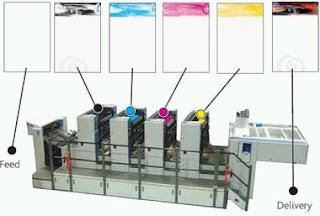1. Colour models CMYK, RGB, Hexachrome, spot colour, PMS pantone matching systems
2. Formats - Standard ISO paper sizes
- A & RSA sizes - Printers work to slightly larger sized paper (12mm)to accommodate bleed
- Imperial(US) V Metric(Europe/ROW)
- Tabloid, Broadsheet, Berliner
- Envelope 'C' sizes
- DL sizes - third a4 (Standard envelope
3. Artwork - Clients signs off proof
Document set up, file formats, fonts(Check copyright or commercial use of fonts), Spellcheck, Colour spec, print marks, pre-flight check, Mockups and proofs
4. Stocks - Weights (GSM - grams per sq. metre)
- Finish - Gloss, silk, matt, coated, uncoated
- Laid or woven fibres
- Boards, cartons
- Plastics & acetates
5. Processes - litho, Gravure, flexo digital, screen or pad
- 4, 6 10 colour printing
- Laminates
6. Finishing - Case binding, Burst binding, Flexi binding, Swiss binding, PVR binding tougher than perfect binding,
- Folding and creasing
- Die cutting
7. Costs - three quotes get first stage quote so can provide client with and estimate before investing a lot of time in the design
- Efficient & economical printing - qties ie <500 digital . > 500 litho?























































